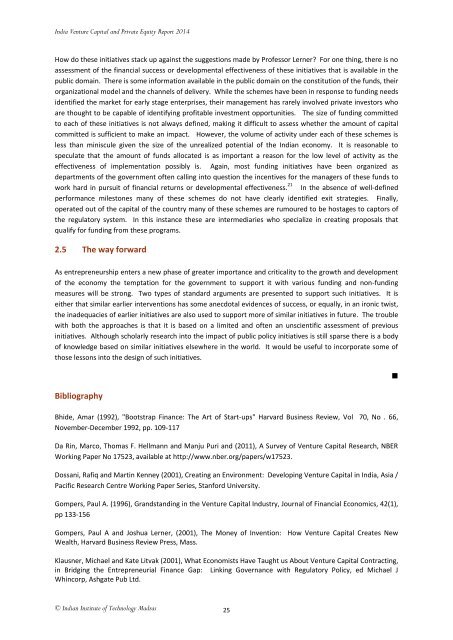Past Reports
2014vcpa
2014vcpa
Create successful ePaper yourself
Turn your PDF publications into a flip-book with our unique Google optimized e-Paper software.
India Venture Capital and Private Equity Report 2014<br />
How do these initiatives stack up against the suggestions made by Professor Lerner? For one thing, there is no<br />
assessment of the financial success or developmental effectiveness of these initiatives that is available in the<br />
public domain. There is some information available in the public domain on the constitution of the funds, their<br />
organizational model and the channels of delivery. While the schemes have been in response to funding needs<br />
identified the market for early stage enterprises, their management has rarely involved private investors who<br />
are thought to be capable of identifying profitable investment opportunities. The size of funding committed<br />
to each of these initiatives is not always defined, making it difficult to assess whether the amount of capital<br />
committed is sufficient to make an impact. However, the volume of activity under each of these schemes is<br />
less than miniscule given the size of the unrealized potential of the Indian economy. It is reasonable to<br />
speculate that the amount of funds allocated is as important a reason for the low level of activity as the<br />
effectiveness of implementation possibly is. Again, most funding initiatives have been organized as<br />
departments of the government often calling into question the incentives for the managers of these funds to<br />
work hard in pursuit of financial returns or developmental effectiveness. 21 In the absence of well-defined<br />
performance milestones many of these schemes do not have clearly identified exit strategies. Finally,<br />
operated out of the capital of the country many of these schemes are rumoured to be hostages to captors of<br />
the regulatory system. In this instance these are intermediaries who specialize in creating proposals that<br />
qualify for funding from these programs.<br />
2.5 The way forward<br />
As entrepreneurship enters a new phase of greater importance and criticality to the growth and development<br />
of the economy the temptation for the government to support it with various funding and non-funding<br />
measures will be strong. Two types of standard arguments are presented to support such initiatives. It is<br />
either that similar earlier interventions has some anecdotal evidences of success, or equally, in an ironic twist,<br />
the inadequacies of earlier initiatives are also used to support more of similar initiatives in future. The trouble<br />
with both the approaches is that it is based on a limited and often an unscientific assessment of previous<br />
initiatives. Although scholarly research into the impact of public policy initiatives is still sparse there is a body<br />
of knowledge based on similar initiatives elsewhere in the world. It would be useful to incorporate some of<br />
those lessons into the design of such initiatives.<br />
Bibliography<br />
Bhide, Amar (1992), "Bootstrap Finance: The Art of Start-ups" Harvard Business Review, Vol 70, No . 66,<br />
November-December 1992, pp. 109-117<br />
Da Rin, Marco, Thomas F. Hellmann and Manju Puri and (2011), A Survey of Venture Capital Research, NBER<br />
Working Paper No 17523, available at http://www.nber.org/papers/w17523.<br />
Dossani, Rafiq and Martin Kenney (2001), Creating an Environment: Developing Venture Capital in India, Asia /<br />
Pacific Research Centre Working Paper Series, Stanford University.<br />
Gompers, Paul A. (1996), Grandstanding in the Venture Capital Industry, Journal of Financial Economics, 42(1),<br />
pp 133-156<br />
Gompers, Paul A and Joshua Lerner, (2001), The Money of Invention: How Venture Capital Creates New<br />
Wealth, Harvard Business Review Press, Mass.<br />
Klausner, Michael and Kate Litvak (2001), What Economists Have Taught us About Venture Capital Contracting,<br />
in Bridging the Entrepreneurial Finance Gap: Linking Governance with Regulatory Policy, ed Michael J<br />
Whincorp, Ashgate Pub Ltd.<br />
•<br />
© Indian Institute of Technology Madras<br />
25


